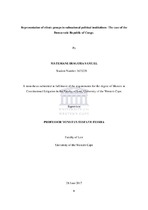| dc.description.abstract | With approximately 450 tribes and 250 ethnic groups in a territory of 2 345 095 km2,1the
Democratic Republic of Congo (DRC) is one of the world's largest, populous, and multiethnolinguistic
countries. Since the departure of the Belgian coloniser in 1960, this Member
State of the Southern Africa Development Community (SADC) is facing a myriad of
institutional crises, bloody conflicts and wars, mainly caused by the design of political
institutions and the side-lining of some ethnic groups from political institutions. For many
decades, Congolese provinces have seen numerous violent ethnic-driven conflicts, which led
to institutional instability, political crisis, secessions, massacres and wars. The bloodiest of
them all were the first and second Congolese wars. From 1996 to 2002, these so-called
"African first world war" cost the DRC the lives of millions of people, divided it into many
small "republics" and destroyed the few political and economic infrastructures that survived
four decades of institutional instability and dictatorship. | |

